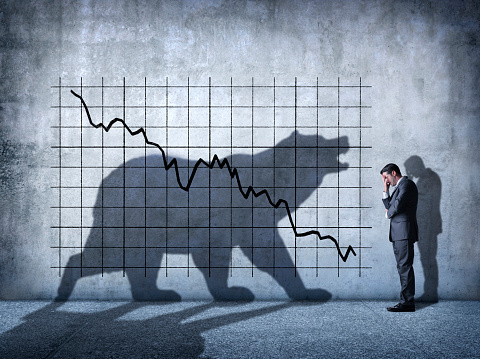Hearing the words “bear market” can be enough to send some investors running for the hills. With the stock market seemingly on a never-ending roller coaster ride, it’s natural to want to avoid any dips. However, bear markets are an inevitable part of investing – and they don’t have to be as scary as they seem. Understanding what a bear market is, and taking active steps to protect your investments, can help you weather the storm and even come out ahead.
Read Dow Jones Stocks: The Complete Guide for Investors.
This article will explore the meaning of a bear market, the different phases, and how you can protect your investment portfolio during these periods. Let’s get started.

What Are Bear Markets?
Bear markets are often associated with a sudden drop in stock prices, which can be accompanied by widespread panic and fear among investors. From a technical perspective, a bearish market is defined as a 20% decline in a security or index price and is typically characterized by widespread pessimism and investor fear.
Usually associated with a decline in the value of an overall market or index, a bearish market is a difficult time for investors. Individual securities or commodities can also be in a bearish market if they experience a drop over typically two months or more. Bear markets occur during general economic downturns, like recessions, and are contrasted with a new bull market.
Phases Of A Bear Market
Several phases are typically associated with notable bear markets, including:
- In the first phase, prices and investor sentiment are both high. However, towards the end of this phase, some investors start to cash out and take profits.
- In the second phase, prices fall sharply while trading activity and corporate profits drop. Additionally, economic indicators that were once positive may become below average. This can cause panic among investors and is referred to as capitulation.
- In the third phase, speculators enter the market, and prices rebound somewhat. Also, the trading volume may increase.
- In the fourth and final phase, prices continue to drop slower. Low prices and good news attract investors again and lead to bull markets. Bull and bear markets tend to alternate in cycles.

How To Invest During A Bear Market?
For many novice investors, bear markets can be scary. Stock prices are falling, and it feels like the bottom could drop out at any moment. But bear markets present opportunities to buy quality stocks at bargain prices with the right investment strategy. If you’re thinking about how to invest during a bear market, here are a few strategies to consider.
1. Diversify Your Holdings
With stocks in a bear market, it’s important to remember that not all stocks will fall in value. Some stocks may even increase in value. So, with a diversified portfolio, you’ll be less likely to lose money if the stock market falls by owning a mix of different types of investments. Also, bonds tend to do well when stock prices are falling, so consider adding some bonds to your portfolio.
Dividend-paying stocks can also be a good choice in an average bear market, as the dividends provide a source of income that can offset any losses from the stock price declines. Also, dollar cost averaging can help in a weak or slowing economy.
2. Invest In Sectors Performing Well In Recession
Even in high inflation and market swings, some sectors continue to perform well in a recession. Everyone still needs to eat, so food companies are often a good investment during an economic downturn. Another sector that often does well in recessions is healthcare, as people will still need medical care even if they’re not spending money on other things. Invest through index funds or sector-specific ETFs to get exposure to these recession-resistant sectors during bear market territory.

3. Don’t Try To Time The Market
Trying to time the market is difficult, and even professional investors often fail. So, don’t try to predict when the market downturns will end, and then make your investment decisions accordingly. You’re more likely to lose money than to make money if you try to time the market based on market history or investment prices.
4. Be Patient
Investing is a long-term game, and bear markets are a normal part of the economic cycle. They don’t last forever; eventually, the stock market will rebound. So, be patient, and don’t sell your investments in a panic. The bear market will eventually end, and your investments will also rebound.
5. Review Your Portfolio Regularly
During a bear market and slowing economy, reviewing your portfolio regularly is important and ensuring that your investment mix is still appropriate for your goals. For example, if you’re getting close to retirement, you may want to adjust your portfolio to be more conservative, as you’ll have less time to make up for any losses during market dips.

Bear Markets Vs. Corrections
Don’t confuse a bearish market with a correction. A correction is a short-term trend lasting fewer than two months. While corrections offer a good opportunity for value investors to find an entry point into stock markets, bear markets rarely provide such an opportunity. This is because it’s almost impossible to determine a bear market bottom. Recouping losses can be difficult unless investors are short sellers or use other strategies to make gains in falling markets.
An example of a recent bearish market is the global financial crisis between October 2007 and March 2009. During that time, the Dow Jones Industrial Average (DJIA) declined 54%.4. The S&P 500 and DJIA most recently entered a bear market in March 2020 on fears surrounding the coronavirus pandemic.
Conclusion
Seeing the market downturn and stock prices fall daily can be disheartening. After all, who wants to see their portfolio take a hit? While it may be painful in the short term, bearish markets provide an opportunity to buy stocks at a discount. Over time, the prices of stocks will rebound, and you’ll be well on your way to achieving your investment goals.
So, bear markets are a normal part of the investing cycle. Don’t panic. Stay the course, and you’ll come out ahead in the end.
Do you have any other questions about bear markets? Let us know in the comments below.


